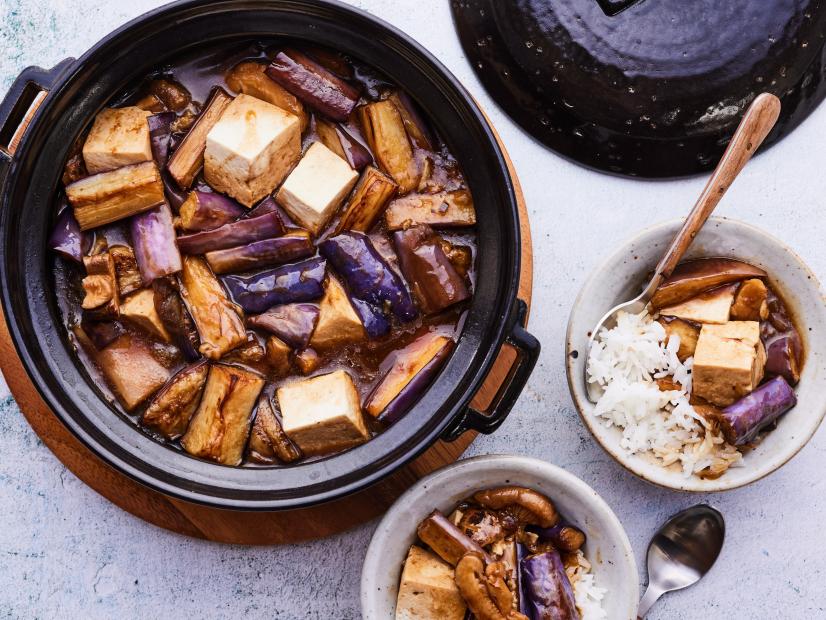
Braised Eggplant with Tofu and Shiitake Mushrooms in a Clay Pot
- Level: Intermediate
- Total: 1 hr
- Active: 40 min
- Yield: 4 servings
-
- Nutritional Analysis
- Per Serving
- Calories
- 328
- Total Fat
- 22 grams
- Saturated Fat
- 2 grams
- Cholesterol
- 0 milligrams
- Sodium
- 1019 milligrams
- Carbohydrates
- 29 grams
- Dietary Fiber
- 7 grams
- Sugar
- 11 grams
- Protein
- 9 grams
- Level: Intermediate
- Total: 1 hr
- Active: 40 min
- Yield: 4 servings
-
- Nutritional Analysis
- Per Serving
- Calories
- 328
- Total Fat
- 22 grams
- Saturated Fat
- 2 grams
- Cholesterol
- 0 milligrams
- Sodium
- 1019 milligrams
- Carbohydrates
- 29 grams
- Dietary Fiber
- 7 grams
- Sugar
- 11 grams
- Protein
- 9 grams
Ingredients
Directions
Special equipment:
a heat-resistant clay pot about 66 ounces (2 quarts)- Bring 4 cups of cold water to a boil in a wok over high heat. Pour the boiling water into a medium bowl and add the dried mushrooms. Cover the bowl with a plate and leave the mushrooms to soak until soft, about 30 minutes. Drain and reserve 2 cups of the soaking liquid. Remove the tough stems and slice the mushroom caps into 1/2-inch-thick slices or halve them if the mushrooms are small. Set aside.
- Meanwhile, thoroughly dry the wok. Add the oil and place the wok over medium heat until the oil registers 350 degrees F on a deep-fry thermometer. Line a baking sheet with paper towels.
- While the oil heats, trim the ends of the eggplants and slice them into 2-inch-long pieces. Slice each piece into 1/2-inch-thick strips or wedges.
- Working in batches, fry the eggplant until golden, about 2 minutes. Drain on the prepared baking sheet.
- Carefully pour off all but 2 tablespoons of the oil in the wok. Place over medium-high heat until it starts to smoke, about 2 minutes. Add the shallots and stir-fry until translucent. Add the garlic and stir-fry until fragrant, about 30 seconds. Add the mushrooms and stir-fry for 1 minute. Swirl in the Shaoxing wine on the perimeter of the wok. Add the chu hou paste and stir-fry until it coats the mushrooms. Add the eggplant, oyster sauce, soy sauce, umami seasoning, sugar, 1/2 teaspoon salt and white pepper. Stir until the sauce coats the eggplant. Add the reserved mushroom soaking liquid and tofu and bring to a boil.
- Mix the cornstarch with 3 tablespoons cold water in a small bowl. Slowly drizzle the mixture into the boiling liquid, stirring until the sauce thickens and coats the tofu (you may not need all of the cornstarch slurry). Transfer the contents of the wok to a 66-ounce (about 2-quart) clay pot (see Cook’s Note), being careful not to break up the tofu. Cover the clay pot and place it over medium heat. Simmer until the eggplant is soft and the tofu is heated through, 8 to 10 minutes. Gently stir in the sesame oil. Serve the eggplant piping hot over rice.
Cook’s Note
The flame-resistant clay pot we tested this recipe with was 8 inches in diameter and 3 inches deep. Check the manufacturer’s instructions for how to season your clay pot. The best way to clean a clay pot is to gently scrub it with warm soapy water, rinse it and then air-dry it overnight. The sauce in this recipe gets some of its richness from chu hou paste, a sweet fermented soybean condiment that famously adds depth of flavor to braised dishes. We also bolstered the sauce with vegetable umami seasoning, an excellent vegan substitute for fish sauce; we tested the recipe with and without the umami seasoning and enjoyed the savory notes it added. However, you can use regular fish sauce (and regular oyster sauce) instead.

































